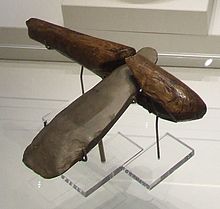
Back Axtfabrikation von Langdale German Industrie des haches de Langdale French Лэнгдейлские каменные топоры Russian
54°26′49″N 3°03′50″W / 54.447°N 3.064°W




The Langdale axe industry (or factory) is the name given by archaeologists to a Neolithic centre of specialised stone tool production in the Great Langdale area of the English Lake District.[1] The existence of the site, which dates from around 4,000–3,500 BC,[2] was suggested by chance discoveries in the 1930s. More systematic investigations were undertaken by Clare Fell[3][4][5] and others[6][7][8] in the 1940s and 1950s, since when several field surveys of varying scope have been carried out.[1][9][10][11][12]
Typical finds include reject axes, rough-outs and blades created by knapping large lumps of the rock found in the scree or perhaps by simple quarrying or opencast mining. Hammerstones have also been found in the scree and other lithic debitage from the industry such as blades and flakes.
The area has outcrops of fine-grained greenstone or hornstone suitable for making polished stone axes. Such axes have been found distributed across Great Britain.[13] The rock is an epidotised greenstone quarried or perhaps just collected from the scree slopes in the Langdale Valley on Harrison Stickle and Pike of Stickle. The nature and extent of the axe-flaking sites making up the Langdale Axe Factory complex are still under investigation. Geological mapping has established that the volcanic tuff used for the axes outcrops along a narrow range of the highest peaks in the locality. Other outcrops in the area are known to have been worked, especially on Harrison Stickle, and Scafell Pike where rough-outs and flakes have been found on platforms below the peaks at and above the 2000- or 3000-foot level.
Recent research has shown that Langdale tuff was used for tools before the Neolithic 'axe factories' were established. In Maryport (Cumbria) it was selected for tool manufacture in the Final Palaeolithic and Mesolithic[14]
Cite error: There are <ref group=lower-alpha> tags or {{efn}} templates on this page, but the references will not show without a {{reflist|group=lower-alpha}} template or {{notelist}} template (see the help page).
- ^ a b Claris, Philip; Quartermaine, James & Woolley, A. R. (1989). "The Neolithic Quarries and Axe Factory Sites of Great Langdale and Scafell Pike: A New Field Survey" (PDF). Proceedings of the Prehistoric Society. 55 (1). Cambridge: Cambridge University Press: 1–25. doi:10.1017/S0079497X00005326. ISSN 2050-2729. S2CID 130925089. (For accompanying material see Supplement 1 of same volume).
- ^ Edinborough, Kevan; Shennan, Stephen; Teather, Anne; Baczkowski, Jon; Bevan, Andrew; Bradley, Richard; Cook, Gordon; Kerig, Tim; Parker Pearson, Mike; Pope, Alexander & Schauer, Peter (2020). "New Radiocarbon Dates Show Early Neolithic Date of Flint-mining and Stone Quarrying in Britain" (PDF). Radiocarbon. 62 (1). Cambridge University Press: 75–105. Bibcode:2020Radcb..62...75E. doi:10.1017/RDC.2019.85. ISSN 0033-8222. S2CID 197554465.
- ^ Fell, Clare (1949). "A stone-axe factory site, Pike o' Stickle, Great Langdale, Westmorland" (PDF). Transactions of the Cumberland and Westmorland Antiquarian and Archaeological Society. 49. Kendal: 214–215. doi:10.5284/1062802. ISSN 0309-7986 – via Archaeology Data Service.
- ^ Fell, Clare (1950). "The Great Langdale stone-axe factory" (PDF). Transactions of the Cumberland and Westmorland Antiquarian and Archaeological Society. 50. Kendal: 1–13. doi:10.5284/1062772. ISSN 0309-7986 – via Archaeology Data Service.
- ^ Fell, Clare I. (1955). "Further Notes on the Great Langdale Axe-factory" (PDF). Proceedings of the Prehistoric Society. 20 (2). Cambridge: Cambridge University Press: 238–239. doi:10.1017/S0079497X00017710. ISSN 2050-2729. S2CID 112636558.
- ^ Bunch, Brian & Fell, Clare I. (1949). "A Stone-Axe Factory at Pike of Stickle, Great Langdale, Westmorland" (PDF). Proceedings of the Prehistoric Society. 15. Cambridge: Cambridge University Press: 1–20. doi:10.1017/S0079497X00019149. ISSN 2050-2729. S2CID 140588391.
- ^ Plint, R. G. (1952). "The Great Langdale Stone Axe Factory" (PDF). Journal of the Fell & Rock Climbing Club of the English Lake District. Vol. 16, no. 2. pp. 121–124.
- ^ Plint, R. G. (1962). "Stone Axe Factory Sites in the Cumbrian Fells" (PDF). Transactions of the Cumberland and Westmorland Antiquarian and Archaeological Society. 62. Kendal: 1–21. doi:10.5284/1062406. ISSN 0309-7986 – via Archaeology Data Service.
- ^ Clough, T. H. McK. (1973). "Excavations on a Langdale axe chipping site in 1969 and 1970" (PDF). Transactions of the Cumberland and Westmorland Antiquarian and Archaeological Society. 73. Kendal: 25–46. doi:10.5284/1062063. ISSN 0309-7986 – via Archaeology Data Service.
- ^ Houlder, C. H. (1979). "The Langdale and Scafell Pike Axe Factory Sites: A Field Survey". In Cummins, W. A. & Clough, T. H. McK. (eds.). Stone Axe Studies: Archaeological, Petrological, Experimental and Ethnographic (PDF). Council for British Archaeology Research Reports. Vol. 23. London: Council for British Archaeology. pp. 87–89. doi:10.5284/1081696. ISSN 0589-9036 – via Archaeology Data Service.
- ^ Schofield, Peter (2005). Stickle Tarn, Great Langdale, Cumbria (PDF) (Report). Lancaster: Oxford Archaeology North. Issue No. 2005-2006/452 (OAN Job No. L9589).
- ^ Schofield, Peter (2009). Axe Working Sites on Path Renewal Schemes, Central Lake District, Cumbria (PDF) (Report). Lancaster: Oxford Archaeology North. Issue No. 2008-2009/903 (OAN Job No. L10032).
- ^ Castleden, Rodney (1992). Neolithic Britain: New Stone Age Sites of England, Scotland, and Wales. London: Routledge. pp. 60, 62. ISBN 0415058457 – via Internet Archive.
- ^ Clarke, Ann & Kirby, Magnus (2022). "Tuff, Flint, and Hazelnuts: Final Palaeolithic and Mesolithic Occupation at Netherhall Road, Maryport, Cumbria". Internet Archaeology (59). doi:10.11141/ia.59.4. ISSN 1363-5387.